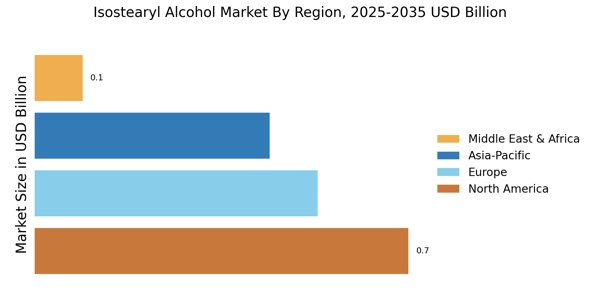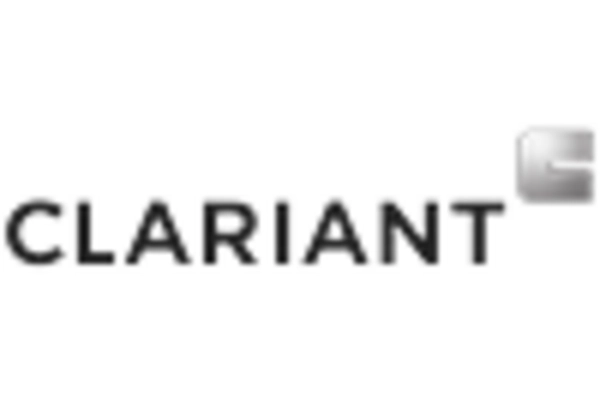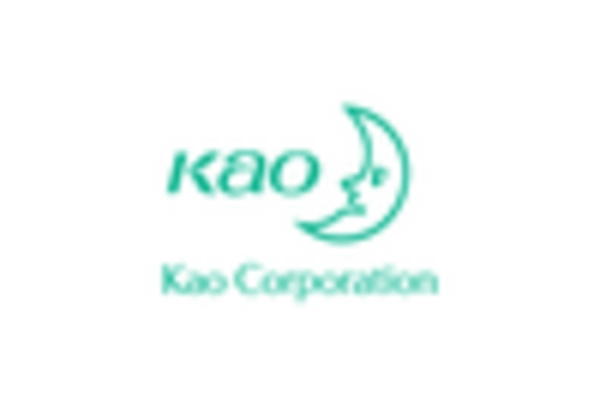Growing Cosmetic Industry
The expansion of the cosmetic industry appears to be a primary driver for the Isostearyl Alcohol Market. As consumers increasingly seek products that offer both efficacy and safety, the demand for high-quality ingredients has surged. Isostearyl alcohol, known for its emollient properties, is widely utilized in formulations for skin care, hair care, and makeup products. According to recent data, the cosmetic sector is projected to grow at a compound annual growth rate of approximately 5% over the next few years. This growth is likely to bolster the demand for isostearyl alcohol, as manufacturers strive to meet consumer preferences for luxurious and effective formulations. Consequently, the Isostearyl Alcohol Market is expected to benefit from this upward trend, as brands incorporate this ingredient to enhance product performance and consumer satisfaction.
Regulatory Support for Safe Ingredients
The regulatory landscape surrounding cosmetic and personal care products is evolving, which may serve as a catalyst for the Isostearyl Alcohol Market. Regulatory bodies are increasingly emphasizing the importance of ingredient safety and transparency, leading to a heightened focus on the use of safe and effective components in formulations. Isostearyl alcohol, recognized for its low toxicity and skin-friendly properties, is likely to gain favor among manufacturers seeking compliance with these regulations. Recent reports suggest that the implementation of stricter safety standards could lead to a 15% increase in the use of approved ingredients like isostearyl alcohol in cosmetic formulations. This regulatory support not only enhances consumer trust but also encourages manufacturers to prioritize the inclusion of safe ingredients, thereby positively influencing the Isostearyl Alcohol Market.
Technological Advancements in Formulation
Technological innovations in formulation techniques are playing a crucial role in shaping the Isostearyl Alcohol Market. Advances in cosmetic chemistry and formulation technology enable manufacturers to create more effective and stable products, which often incorporate isostearyl alcohol due to its beneficial properties. For instance, the development of microencapsulation technology allows for the enhanced delivery of active ingredients, improving product performance. Market analysis indicates that the adoption of such technologies could lead to a 20% increase in the incorporation of isostearyl alcohol in new product launches. This trend suggests that as formulation techniques continue to evolve, the Isostearyl Alcohol Market will likely see increased demand as brands strive to innovate and differentiate their offerings.
Rising Demand for Multi-Functional Ingredients
The trend towards multi-functional ingredients in cosmetic formulations appears to be a significant driver for the Isostearyl Alcohol Market. As consumers seek products that provide multiple benefits, manufacturers are increasingly formulating with ingredients that serve various purposes. Isostearyl alcohol, known for its emollient, thickening, and stabilizing properties, fits this demand perfectly. Recent market data indicates that products featuring multi-functional ingredients are experiencing a growth rate of approximately 8% annually. This trend suggests that the Isostearyl Alcohol Market may benefit from the rising preference for versatile ingredients, as brands look to streamline formulations while enhancing product efficacy. Consequently, the incorporation of isostearyl alcohol into diverse product lines is likely to become more prevalent.
Increasing Awareness of Sustainable Ingredients
There is a notable shift towards sustainability within the beauty and personal care sectors, which seems to be influencing the Isostearyl Alcohol Market. Consumers are becoming more conscious of the environmental impact of their purchases, leading to a preference for products that utilize sustainable and responsibly sourced ingredients. Isostearyl alcohol, derived from natural sources, aligns well with this trend. Market data indicates that products labeled as 'sustainable' or 'eco-friendly' are witnessing a significant increase in sales, with some segments reporting growth rates exceeding 10%. This heightened awareness is likely to drive manufacturers to incorporate isostearyl alcohol into their formulations, thereby enhancing the appeal of their products in a competitive marketplace. As a result, the Isostearyl Alcohol Market may experience a positive impact from this growing consumer demand for sustainability.


















Leave a Comment